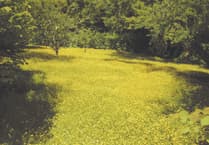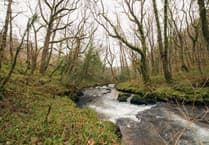Rare cirl buntings have enjoyed a 33 per cent population boost on National Trust farmland in the South Hams this year.
Sixty breeding pairs have been recorded between Bolt Head and Bolberry Down, compared to forty in previous years - the highest count of the small birds in the area since records began in 2012.
The area is one of the most important sites for cirl buntings in the UK, which are currently classified as red conservation status.
The National Trust has worked to improve habitat and food sources for the birds by making small changes to farm animal grazing patterns along the coastline.
A mixture of sheep grazing during the winter and low-level cattle grazing in the summer months has helped to create a rich grassland abundant with wildflowers.
This has helped to improve habitats for cirl buntings, but also the insects and native seeds they eat.
The trust worked with farm tenants in the area and the RSPB (Royal Society for the Protection of Birds), and it is hoped the increase in available food sources and habitat for the birds will help maintain the larger population of sixty pairs.
Emma Reece, the trust’s area ranger for South Devon said: “A simple tweak to how we work with the grazing animals used has made this positive change.
“We plan to do more nature-friendly farming in the area which we hope will help sustain the cirl buntings.
“This will include allowing a mix of grazing techniques and allowing the borders around fields to grow, providing a variety of food sources for birds, bees and butterflies.
“We know it might look a little untidy, but this vital mix of long grasses and wildflowers is just what nature likes and needs to flourish.”
Patches of scrubby gorse, blackthorn and thick hedgerows have been created, which help to provide nesting sites and cover on the exposed coastal farmlands.
The birds also need well managed grasslands full of wildflowers so there are lots of insects, such as grasshoppers, to feed on through the spring and summer when they are breeding.
In winter they feed on seeds dropped from cereal harvest.
Leaving large areas of stubble for them to forage helps provide access to this important food source for cirl buntings, and overwintering skylarks have also been seen benefiting too.
The trust has also recently planted an extra kilometre of new hedgerow at Southdown Farm to provide more habitat and shelter for wildlife.
Local ornithologist, Rob Macklin, who has monitored the local cirl bunting population for the past six years, said: “Recent work by the National Trust to improve the habitat requirements for this iconic species, including the provision of winter feeding opportunities by creating areas of wild bird food and leaving overwintering stubbles, should ensure that this nationally important population continues to thrive.”
Work has been going on through South Devon to improve habitat for cirl buntings since the 1990’s when their numbers declined to only 118 pairs nationally in 1989 and the RSPB launched a successful project to improve their habitat.





Comments
This article has no comments yet. Be the first to leave a comment.